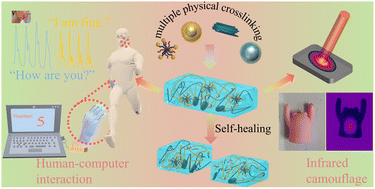Self-healing liquid metal hydrogel for human–computer interaction and infrared camouflage†
Abstract
Due to their mechanical flexibility, conductive hydrogels have been widely investigated in the fields of flexible electronics and soft robots, but their non-negligible disadvantages, such as poor toughness and limited self-healing, severally restrict their practical application. Herein, gallium indium alloy (EGaIn) is utilized to initiate the polymerization and simultaneously serve as flexible fillers to construct a super-stretchable and self-healing liquid metal/polyvinyl alcohol/p(acrylamide-co-octadecyl methacrylate) (liquid metal/PVA/P(AAm-co-SMA)) double network hydrogel (LM hydrogel). The synergistic effect of the rigid PVA microcrystal network and the ductile P(AAm-co-SMA) hydrophobic network, together with the ionic coordination and hydrogen bonds between polymer networks (multiple physical cross-links), endow the LM hydrogel with excellent super-stretchability (2000%), toughness (3.00 MJ m−3), notch resistance, and self-healing property (healing efficiency > 99% at 25 °C after 24 h). The LM hydrogel exhibits sensitive strain sensing behavior, allowing human–computer interaction to achieve motion recognition and health monitoring. Significantly, owing to the excellent photothermal effect and low infrared emissivity of EGaIn, the LM hydrogel reveals great potential in infrared camouflage. The work of self-healing conductive liquid metal hydrogels will promote the research and practical application of hydrogels and liquid metal in intelligent devices and military fields.

- This article is part of the themed collections: 2024 Materials Horizons Lunar New Year collection and 2023 Materials Horizons Most Popular Articles


 Please wait while we load your content...
Please wait while we load your content...